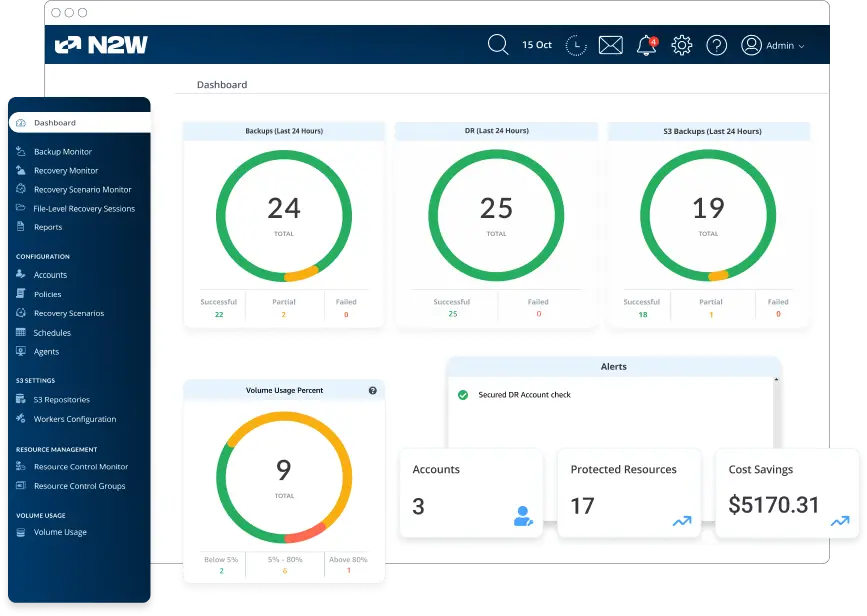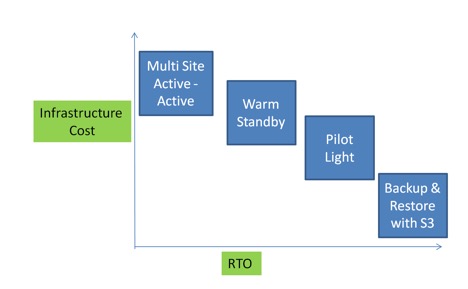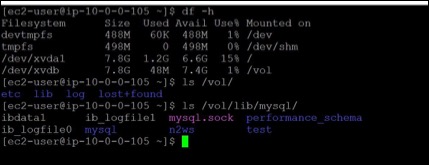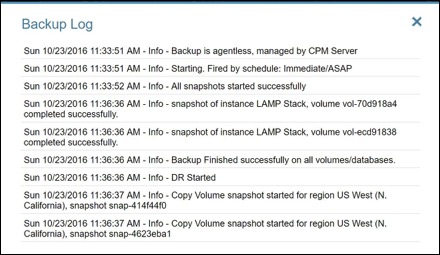With ransomware frequently making headlines, compliance regulations coming into force, and numerous errors and bugs leading to customer frustrations, downtime and revenue loss, it’s understandable that businesses are making disaster recovery and business continuity a high priority. Outages within AWS regions have happened and bound to happen again and it’s one of the many reasons for downtime. For this reason, it is widely considered best practices to perform AWS cross region backup and recovery drills.
What is Disaster Recovery?
Disaster Recovery (DR) is a process that helps you prepare for any kind of unwanted disaster. The DR process is designed to reduce the negative impact on a company due to a loss of any service. In the production world of scalable applications, DR is just as important as any other nonfunctional requirement. AWS cross region backup is particularly important In this article, we will discuss how to perform AWS cross region backup using N2W effectively to achieve proper Disaster Recovery for AWS.
In this article, we will briefly describe the different DR options on AWS as well as provide you with a step-by-step guide to automating your AWS cross-regions DR considering your RTO and RPO preferences.
- Save days of work by automating your DR testing process
- Recover your entire instance to a production state in minutes
- Reduce storage costs instantly with N2W AnySnap Archiver

What are RTO and RPO?
One of the key aspects of DR is identifying your RTO & RPO to help design the right DR solution. Let’s first understand the two key SLA parameters for disaster recovery.
RTO stands for Recovery Time Objective.
It is the time taken by an organization to restore the service after it was disrupted due to some disaster. For example, if a site was down due to some major issue at 11:30 PM and the SLA for the site says that it should be back and up by maximum 1:30 AM, the RTO is two hours.
RPO stands for Recovery Point Objective.
The RPO defines the maximum amount of data that can be lost and measured in time. For example, if a site was down due to some major issue at 11:30 PM and the SLA for site says it should lose maximum data between 10:30 PM and 11:30 PM, in this case, the RPO of the site is 1 hour and system should have planned for backup every hour to meet the RPO.
When we talk about DR, there are various options available for achieving different levels of DR on AWS including Pilot Light, Hot Standby, and Active-Active / Multi-site setup.
RTO & RPO come with a cost. With various kinds of DR options mentioned, you can see below that the lower the RTO/RPO is, the higher the cost of the infrastructure (DR process) will be.

A company should determine its RPO & RTO plans based on the costs involved and the liability to its users. AWS itself offers an SLA of 99.95% for most of its services considering the unforeseen disasters. In addition, if you require a higher SLA level, automation of cross-region backup and a failover mechanism might be important requirements.
How to Automate DR on AWS with N2W
N2W is a full-featured enterprise-class backup, recovery, and DR solution for Amazon EC2 Instances, EBS volumes, RDS databases, Redshift clusters, Aurora, DynamoDB and EFS, utilizing the AWS native EBS and RDS snapshots.
Starting with AWS Cross Region Backup
As shown below, we have deployed a production LAMP stack on AWS EC2. For our demo, the additional volume has MySQL database installed. We will show how we backup and recover cross-region.

1. Considering that we are planning an RPO of one hour, we have configured the N2W policy to schedule an automated backup every hour.
2. N2W is configured to take backup of both the root as well as the additional EBS volume of the instance.
3. For the DR, we are planning to have a copy of the snapshot available in a separate region.
You can use AWS tools to manually copy the snapshots or use the N2W that does it automatically.
As shown below, when using N2W, you can easily set a policy to create an automated copy of the snapshot to any of the other AWS regions.
In order to enable that, you should select the target region or multiple regions and set the “performing DR” frequency in terms of backup. You may want to copy snapshots of every backup to other regions, which is the default option. However, this might impact your storage costs, so it’s better to set this one to your own specific requirements.
In addition, the “DR Timeout” is required since the copy snapshot is happening over WAN and the copy process duration depends on the volume of data. If the DR process is not completed in a certain timeframe (in hours), N2W assumes the process is hanging and will declare that the copy has failed. In addition, N2W provides an advanced option to run cross AWS account backup.
Once the policy is configured, N2W will automatically start taking a snapshot every hour and copy it over to the target region.
We can check the logs of the completed snapshots for more information:

Here, it is important to note that when a snapshot is copied over to separate region, it is copied over WAN. This will be a slower process than copying a snapshot to another availability zone in the same region. AWS also charges a data transfer fee for copying data from one region to another. As of October 2016, AWS charges at $0.02 / GB to transfer from the US East region to any other region.
The GIANT Recovery button makes recovery quick + straightforward
N2W gives a quick and easy option to recover the instance within a target backup region.
Select your instance from the Backup Monitor and, to restore to another region, select the desired region from the drop down in the top right. Then you can either click “Recover” to restore the full instance, recover just the volumes, or explore volume files.
Configure the parameters as needed. Recovery of an EBS volume is pretty straightforward, but for an instance, you will have additional options. You should be able to run with the default settings but you can also change the parameters for things like the instance type, VPC (i.e. subnet), key pair, and security group.
Once all parameters are configured correctly, N2W will auto-restore the instance in the target region.
Make sure you plan your AWS cross region backup requirements
In this article, we have achieved the automated cross-region replication. It is important to note that RPO & RTO comes with a cost, including the snapshots data storage costs as well as data transfer. Under this consideration, you should define the required uptime and plan your backup and DR frequency. You may plan for backup every day to separate the regions instead of the N2W hourly default.
Finally, N2W facilitates automation and management of your cross AWS region backup and recovery, providing you the ultimate protection and confidence that your data and applications are safe.

Ezra is the Sr. Director of Alliances and Partners at N2WS with more than 10 years of experience. Ezra enjoys long bike rides, cultivating rare semi-succulents, and building complex aquatic ecosystems.